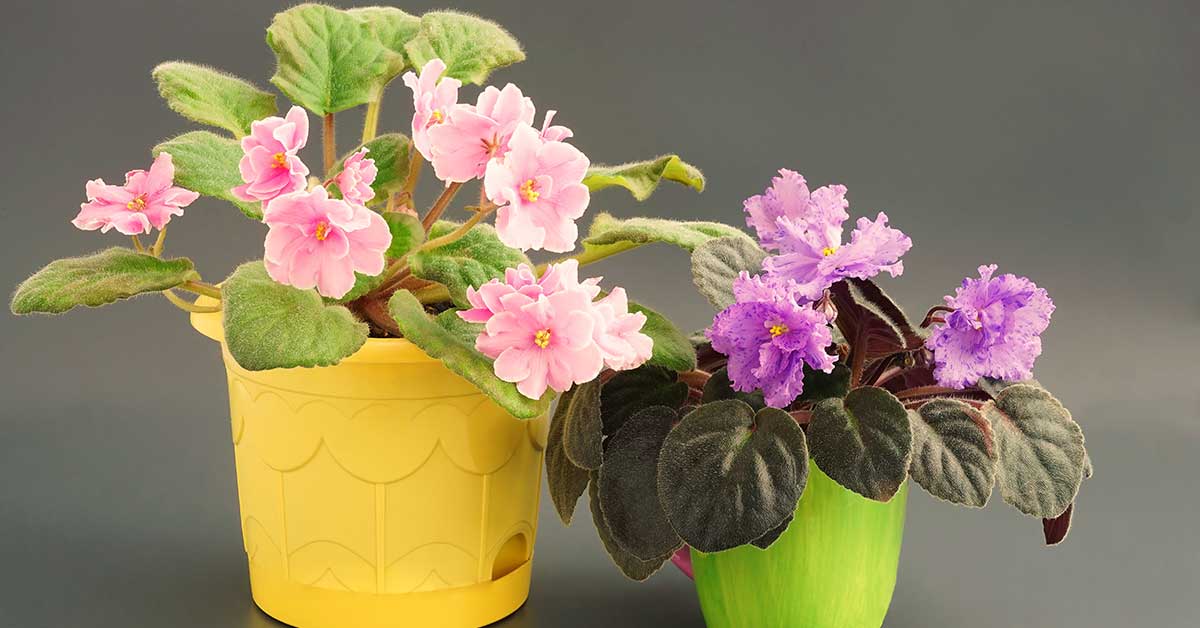African Violets (Saintpaulia) are one of my favorite houseplants due to their long-lasting flowers, fuzzy leaves, and generally low-fuss maintenance. But one of the more common questions I get about this houseplant is about yellowing leaves. Why your African Violet leaves are turning yellow may have a few different answers, but fortunately, it’s not a very difficult issue to correct. Still, yellowing leaves are your plant’s way of saying ‘I need help!’ Diagnosing the exact cause of the yellowing is an important first step in fixing it. So in this article, we’ll examine why it is your African Violet is turning yellow and what you can do to fix it.
Why your African Violet leaves are turning yellow
African Violets are a popular houseplant because of how no-fuss they are. They can tolerate a range of conditions, have interesting, fuzzy leaves, and produce absolutely lovely, long-lasting flowers. But when your African Violet leaves are turning yellow, it can be cause for alarm. The good news is, if you catch it early enough, you can correct the issues causing the yellowing leaves. There are 5 primary reasons why African Violet leaves start turning yellow.
Read Next: Why Your African Violet Leaves Are Curling
Improper watering
If you don’t know much about African Violets, it can be easy to assume they’re just like any other houseplant. Toss a little water on them, give them some light, and you’ve got a nice, healthy plant. But African Violets have slightly complicated watering needs. You see, the fuzzy leaves of an African Violet plant don’t tolerate coming into contact with water. If you’re watering in such a way that water gets on the leaves, that’s probably the reason why your African Violet leaves are turning yellow.
The yellowing of the leaves from water touching them is purely aesthetic – the leaf isn’t actually being harmed, just discolored. That said, if water becomes trapped on the leaves, it can eventually cause the leaves to rot. When watering your African Violets, always water from the bottom. Fill a tray up with water and place your African Violet plant in it. After about 30 minutes, remove the plant from the water.
Watering with cold or hot water
Another common problem that causes yellow African Violet leaves is not watering with room temperature water. Providing water that is either too hot or too cold can harm the plant and cause deadly yellowing to occur. Water from the tap is fine for watering African Violets, but allow it to come to room temperature before administering.
Sunscald
African Violets are fussy about their sunlight requirements. They like a little bit of sun, but not too much. But also not too little. If your African Violet is placed in direct sun for many hours in a day, there’s a good chance that the yellowing is sunscalding or sunburn. Your best bet is to set your plant in a location that maybe gets a little bit of sunlight but otherwise gets just bright indirect light. Early morning sun is usually fine for African Violets.
Nutrient deficiency
If your African Violet leaves are turning yellow at their edges, or even along the leaf’s veins, chances are, you’re looking at a magnesium deficiency. It’s also possible your plant is deficient in zinc and/or iron. In any case, it’s definitely a nutritional deficiency. But that’s easy to fix. Providing an organic fertilizer with a balanced NPK level will provide your African Violet with the nutrients it’s missing. An even safer bet is to select an organic fertilizer specifically for African Violets. That way, you can be pretty much certain your houseplant is getting what it needs to survive.
Repotting is needed
If you’ve provided your nutrient-deficient African Violet with a good fertilizer and it still seems to be suffering from nutrient deficiency, it’s very likely that your African Violet needs to be repotted. It’s an easy detail to overlook since the African Violet is generally a pretty small plant. But in order to be healthy, you need to repot this plant about every 6 months. Over time, the nutrients in the soil degrade to the point that not even fertilizer can replenish it, so you need to provide your violet with new soil.
Repotting an African Violet is easy.
- Remove the plant from its pot by tipping it on the side and gently pulling it out of the pot.
- Loosen the soil at the base of the root ball. Be mindful that you aren’t damaging the roots or getting rid of too much soil.
- If any roots appear to be infected with root rot, carefully cut the infected roots away.
- Select a pot just slightly larger and fill about 30% of the way with new soil.
- Place your African Violet in the pot and begin filling in any vacant space in the pot with fresh potting soil.
- Once repotted, provide a hearty watering from the base of the plant, being mindful not to get any water on the leaves.
Should I remove the yellow African Violet leaves?
The decision to remove any yellow African Violet leaves should be determined by your assessment of the health of the leaf. If you believe that a leaf has yellowed because of damage, like from improper water temperature, prolonged nutrient deficiencies, or sunscald, then yes, it is probably best to remove the yellowed leaves. Yellow leaves won’t heal and turn green again, and as they die, they may become diseased.
If your African Violet leaves are turning yellow because of water spots, this is generally not a good cause for removing the yellow leaves. This damage is only aesthetic and the leaf is otherwise healthy.













